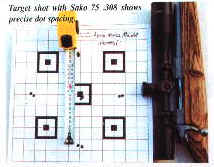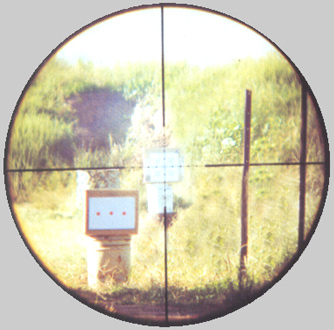

A Mil-Dot scope is a scope with a reticle, which has dots spaces apart to coincide with a 100mm movement at 100 m (1 mil is 100 mm at 100m, or 3.4 MOA at 100 yards).
The new Mil-Dot 10x42 monotube scope from lynx is unusual in many respects it has a 42mm objective with a 30mm tube, three target type turrets, one for up and down, one for left and one for left to right and a third turret on the left hand side for parallax adjustment! The ocular housing is large at 46mm O.D.
Optically this scope is as smart as any 10x I have looked through. I was able to compare it directly with a 10x Leupold and for my eye the Lynx would get the nod! While in the process of dighting in the first couple of shots after bore sighting were fired at 50 yards where parallax can be a problem, especially for higher power scopes. With the dial set on 50 parallax was undetectable and the same at 100 yards with the dial set to 100. Parallax was undetectable until the field of view was reduced to less than 50%, meaning that the parallax adjustment in this particular scope is very close to perfect. I might ass that parallax or the lack of it on all Lynx scopes has been a feature.
The reticle is quite a simple affair with a sniper crosswire with a series of dots strategically placed, four above four below, four to the left and four to the right of the cross. Now for this scope to be anything but just another scope with a fancy reticle the dots have to be placed exactly the same distance apart. For testing we fitted the Lynx Mil-Dot 10x to a Varmint Sako.308 Win Stainless/laminated rifle. During the course of sighting in, groups shot with this rifle were as follows: 4 x3-shot groups at 100 yards ranged from .184” to .956’ and 3 x 5-shot groups ranged from .530” to .824”. The rifle has what it takes to test a scope very thoroughly and has enough recoil to keep and scope honest. The specifications from lynx for the dot placements are as follows:
*Distance between dots centre to centre, 1 Mil
*Dots cover ¾ MOA (3.4 MOA at 100 yards (minute of angle/Arc) =1 Mil)
1 MOA = 29 mm at 100 metres
1 Mil =100mm at 100 meters
1 Mil subtends one thousandth of the views distance (that is, 1 meter at 1000 meters.)
In the process of trying to devise a test that would mean something to anyone reading this I started by firing a group at the bottom square of the Guns & Game target and fired a group using a centre hold with the cross, then went one dot below the cross (that is took the cross up the target 1 Mil, approximately 3.5” at 100 yards not metres). Using the dot as the aiming mark with the centre hold I fired another 3 shots. I then came back down the target and fire three shots using one dot on the right hand side of the cross, taking the cross to the left of the aiming mark and fired three shots. Using the data already stated above from Lynx these four groups should be approximately 90mm (3.5”) apart, remembering I shot these at 100 yards (90m). To the best of my measuring ability using a dial vernier calliper, all four groups were on 90mm centres meaning that this scope’s reticle is sufficiently well designed and built to be reliable varmint target scope out too as far as you or I are game to have a go !. With the target set at 100 metres (not yards) 5 x 2-shot strings were fired in the same sequence as above and all bullets printed very close to 100mm apart, which is where they theoretically should be.

Target shot with Sako 75 .308 shows precise dot spacing.
I know the modern trend is for large target turrets on scopes , but with this absolutely precise reticle system I am at a loss to see the need , as they only serve as a leverage point to help upset the scope/rifle when being handled. As this Mil-Dot scope principle is designs around military/tactical usage, ordinary small turrets would have to be more reliable. A system where the turrets were in place of the lower turret caps would be my choice.
Field shooting is a bit limited at the moment due to all the rain experienced recently but I was able to shoot a large fox in the head at around 100 metres and took the combination out professional shooting and the Lynx performed perfectly. For the record only one shot was missed out of 15. I also secured a pig at 35 metres and a couple of foxes at 150 metres seeing these targets in the spotlight was no trouble at all. Overall, Full marks to Lynx, for what appears to be another great product.

Target at 100 yards as seen through the 10x42 Mil Dot scope.